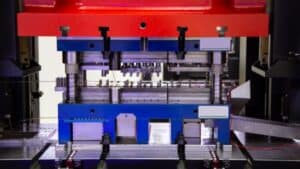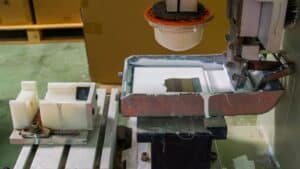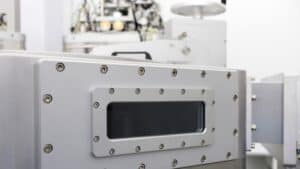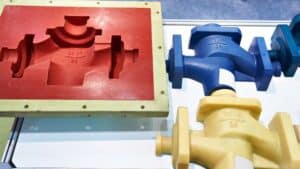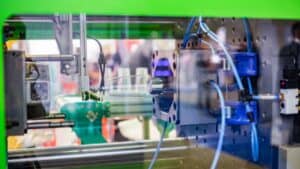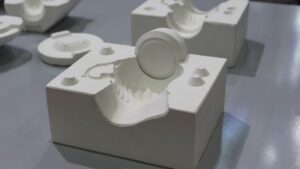CNC machining is a machining process with many specific techniques, and step turning is one of them. This cutting operation involves material removal from a workpiece along its length. It is a fundamental machining operation used to create precision parts with varying diameters in a single setup. In this blog, we will go over the basics of step turning so you can gain a better understanding of this machining technique.
Definition, Features, and Applications of the Step Turning Method
Step turning is a machining operation that removes material in distinct axial zones parallel to the axis of a rotating workpiece, producing multiple cylindrical segments of different diameters. Each change in diameter forms a “shoulder” that must be both dimensionally accurate and visibly crisp unless otherwise specified.
During step turning, the machine establishes one diameter at a time, shifting the tool position along the axis to create a series of segments. The result is a “stepped” profile: flat cylindrical lands separated by abrupt transitions. On CNC lathes, coordinates are programmed to index precisely to the next station, ensuring repeatable lengths and shoulder locations across parts.
Typical Terminology
| Feature | Definition |
|---|---|
| Step | A cylindrical section with a specific diameter and length. |
| Shoulder | The transition face between adjacent steps, typically perpendicular (90°) to the axis, but can be angled in some designs. |
| Step Length | The axial length of an individual step. |
| Overall Length | The total axial length of the part. |
| Edge Break | A slight chamfer or radius applied to remove sharpness. |
Where Step Turning Is Used
Step turning appears everywhere in mechanical systems: automotive shafts and axles, fastener bodies with multiple diameters, valve stems, bushings, pump components, and stepped pulleys. The purpose of step turning is to produce parts that meet specific design requirements, with mounting surfaces and shoulders for reliable fitment, so that they can interface smoothly with different mating components, bearings, gears, couplings, and spacers.
Machines, Tools, and Setup Essentials
Step turning can be performed by both manual lathe operation and CNC machining. The core requirements are largely similar: secure workholding, axial alignment, a rigid tool setup, and a clear plan for the order of cuts. In this part, we will foucs on how step turning in CNC machining is conducted.
Workholding and Centering
- Workholding: Three‑jaw chucks, collets, or soft jaws hold the work. Collets offer superior concentricity on ground bars, while soft jaws are ideal for custom diameters and delicate surfaces.
- Support: Long, slender parts benefit from a tailstock center or a steady rest to prevent deflection and chatter during shoulder cuts.
- Axial alignment: This is primarily ensured by the inherent accuracy of the CNC machine, spindle, and workholding (chuck or collet). For the highest precision requirements, indicating the OD (outer diameter) or using a ground register can be performed during setup to verify and fine-tune alignment.
Cutting Tools, Inserts, and Geometry
- Tool type: A indexable insert or single‑point turning tool is used to handle the bulk of step turning. A robust tool nose that can take interrupted loads at shoulder entry is preferred. A parting tool may be used for specific reliefs or grooves.
- Geometry: Positive rake with adequate clearance reduces rubbing: a small tool nose radius helps in achieving a sharper shoulder corner. However, a larger radius improves tool life and surface finish but will create a small fillet at the shoulder.
- Specialized tools: Grooving or profile tools may be used to clean up shoulders or generate reliefs and chamfers efficiently.
Speeds, Feeds, Coolant, and Measurement
- Speeds/feeds: Match to material and tooling. Harder alloys demand conservative surface speed and tougher inserts. For example, aluminum being a relatively soft metal, allows higher speeds and generous feeds. Start with manufacturer recommendations and adjust based on chip formation and tool wear.
- Coolant: Useful for chip evacuation and temperature control, especially in steels and stainless. In free‑machining materials, dry or mist cutting can be fine when chips break well.
- Measurement: After the CNC process, a caliper is often used for measuring diameter changes and step lengths during setup and inspection.
How the Step Turning Process Works
Step turning produces precise, cylindrical features of different diameters on a single workpiece. To do this successfully, focus on three key principles: meticulous planning, maintaining rigidity during roughing, and executing careful, controlled finishing passes.
Planning From The Drawing
For CNC lathes, the planning happens in the program, where you define the tool path coordinates and include verification moves to ensure each step is cut cleanly. A key efficiency tactic is to sequence operations to complete as many features as possible with one tool before switching, which minimizes tool changes and reduces cumulative error.
Rough Cut and Sequencing for Rigidity
The goal of roughing is to remove material efficiently without harming stability. Always work from the most rigid condition to the least. A common and effective strategy is to rough the largest diameters first. Leave a small, uniform finishing allowance on each step.
Rigidity is a very critical influencing factor. Keep both the tool and workpiece overhang to an absolute minimum. For slender shafts, use a tailstock center or follow rest to counteract deflection and suppress vibration. For chip control, select an appropriate feed rate and depth of cut to encourage chips to break.
Finishing Shoulders, Chamfers, and Blends
Finishing passes require a lighter touch and more control on the surface of the workpiece. Take light, consistent cuts to achieve the final size and desired surface finish. When approaching a shoulder, maintain a stable, continuous feed to avoid dwell marks.
For a high-quality square shoulder, face the shoulder lightly after turning the adjacent diameter. If the drawing allows, adding a small chamfer or undercut at the step helps with assembly and protects the edges from damage. Have a deburring strategy in mind: break all sharp edges on non-datum corners. If a sharp edge is functionally required, it must be masked during the deburring process and carefully verified afterward, potentially under magnification.
Deburring and Inspection
In the CNC process, deburring often involves removing burrs from step edges and shoulders using dedicated deburring tools. Finally, conduct a thorough inspection to measure all diameters for accuracy.
Tolerances, Surface Finish, and Quality Control
Precision step turning balances diameter control, shoulder geometry, and surface finish.
Dimensional Control and Squareness
- Tolerances: Many stepped shafts call for ±0.001 in diameter or tighter. Step lengths may be held to similar bands depending on function. Shoulders often reference a datum and may include perpendicularity or runout limits.
- Squareness: Verify shoulder faces relative to the datum axis with an indicator sweep or by assembling mating components during first‑article checks. Any taper or tool deflection will show up as out‑of‑square shoulders.
Surface Roughness and Edge Breaks
- Finish targets: Functional lands for bearings and seals commonly require smoother finishes than non‑critical surfaces. Achieve the target Ra through appropriate nose radius, finishing passes, and, if necessary, light polishing, ensuring no dimensional drift.
- Edge breaks: Unless a sharp corner is specified, a controlled chamfer or small radius protects edges, eases assembly, and reduces the risk of burr formation during service.
Defects and Solutions in Turning Operation
In step turning, small setup issues quickly become apparent as size errors, chatter, or shoulder defects. A concise playbook is essential for resolution.
Oversize/Undersize Steps
The root causes for size errors include incorrect tool offsets, thermal growth, inconsistent measuring force, or taking spring cuts that fail to remove material. To correct this, re‑touch off tools, allow the part and tool to reach thermal equilibrium, and use a consistent micrometer technique. Always leave a predictable finishing allowance and verify the actual chip load to avoid non-productive “air cuts.”
Chatter, Taper, and Tool Wear
Chatter is resolved by reducing tool and work overhang, adding support with a tailstock or steady rest, and slightly increasing the feed or reducing the speed to move out of a resonant zone. Switching to a sharper insert with positive rake also helps. Taper requires checking tailstock alignment, verifying spindle or chuck runout, and ensuring the tool is set exactly on center height. On CNC machines, confirm compensation values and thermal offsets. Tool wear is critical as stepped profiles punish dull tools at shoulder entry. It is important to track tool life, replace inserts promptly, and inspect the cutting edge for micro‑chipping that rounds shoulders.
Burrs and Poor Shoulder Finish
These defects are typically caused by dull tools, an excessive nose radius for the feature, or rubbing from too light a feed near the shoulder. The remedies are to use a smaller nose radius for sharp shoulders, maintain a steady finishing feed into the shoulder, and perform a light facing cleanup cut.
Safety and Chip Control
Always keep guards in place, wear eye protection, and use a chip hook or brush—never hands—for chip removal. Shoulder cuts can throw hot, curled chips toward the operator, so apply coolant or adjust chip‑breaker geometry to control their flow. Always pause to clear chips before measuring near shoulders.
How Step Turning Compares to Related Operations
Step turning is often discussed alongside a few neighboring operations. Understanding the distinctions avoids modeling or programming mistakes.
Straight Turning, Grooving, and Facing
- Straight turning: This refers to creating a single, consistent diameter along the length of a workpiece. Step turning can be thought of as multiple instances of straight turning performed at different axial positions to create stepped diameters.
- Grooving: Produces narrow recessed features or reliefs, not broad diameter changes. Grooves may accompany step turning to provide reliefs at shoulder roots or for retaining rings.
- Facing: Squares the end of the work or a shoulder face. It complements step turning to finalize step lengths and shoulder finish.
Taper Turning and Form Turning
- Taper turning: Creates a gradual, conical transition rather than an abrupt shoulder. Use tapers for interference fits or alignment features where a stepped change would be too abrupt.
- Form turning: Uses special tools or CNC profiles to generate complex contours. It can include steps within a more complex shape, but the intent is non‑linear geometry rather than discrete flat lands.
CNC Versus Manual Considerations
- CNC lathes: Offer repeatability, easy sequencing of multiple steps, canned cycles, and accurate shoulder positions across batches. Perfect for multi‑diameter shafts with tight tolerances and documentation requirements.
- Manual lathes: Ideal for prototypes or low volume when an experienced operator can scribe transitions, set stops, and measure frequently. Success relies on careful marking, consistent technique, and disciplined in‑process checks.
Conclusion
Step turning is a fundamental machining technique used to create parts with multiple diameters and precise shoulders in a single, efficient setup. Its key advantage is ensuring accurate dimensions and relationships between features, which is essential for parts that must fit correctly with other components.
Mastering this process requires understanding the entire machining workflow, from planning to verification. As a versatile and essential skill, proficiency in step turning forms the foundation for more complex machining tasks and is crucial for manufacturing the stepped parts found in most mechanical assemblies.

